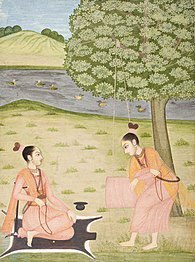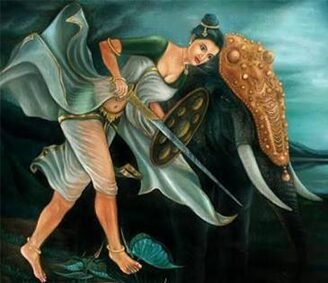The Mystical World of Yoginis: Unveiling the Power of the Feminine Divine

Yoginis hold a unique and multifaceted place in the spiritual, cultural, and historical traditions of South Asia. Far beyond the image of a yoga practitioner, the term “yogini” encapsulates divine feminine power, mystical transformation, and spiritual mastery. Their influence is woven into the fabric of tantric practices, temple architecture, and devotional literature. This article delves into the historical, spiritual, and symbolic significance of yoginis, providing an in-depth analysis of their legacy.
Origins
The concept of the yogini originates from early tantric traditions and Shaiva worship, which flourished during the early medieval period (8th–13th centuries CE). The term “yogini” derives from the Sanskrit word yogi, indicating a female practitioner of spiritual disciplines. In tantric contexts, yoginis were perceived as powerful, supernatural beings who wielded shakti (feminine energy).
Yoginis emerged as central figures in esoteric tantric rituals aimed at achieving spiritual enlightenment and harnessing cosmic power. Their worship was particularly prominent in the Kaula and Shakta traditions, which emphasises the veneration of the divine feminine as the source of creation and transformation.
Representations and Symbolism
Yoginis are often depicted as shapeshifting, mystical beings who embody both divine and earthly attributes. In artistic and sculptural depictions, they appear as composite forms, blending human and animal features. These representations highlight their connection to primal energies, transformation, and the cyclical nature of existence.
The association of yoginis with birds, such as owls or peacocks, symbolises their ability to transcend earthly boundaries and connect with celestial realms. This imagery reinforces their role as mediators between the material and spiritual worlds.
Characteristics of Yoginis
Divine and Human Nature
From around the 10th century, yoginis began appearing in groups, often numbering 64. They are typically portrayed as goddesses but are also believed to be embodied by female tantric adepts. This duality creates an ambiguous boundary between the human and the divine, emphasizing their transformative and mystical nature.
Mystical powers
Yoginis are renowned for their extraordinary abilities, which transcend ordinary human capacities. These powers, often described as siddhis in yogic and tantric literature, include:
- Shapeshifting: Yoginis are frequently depicted as theriomorphic beings, combining human and animal traits. Statues and iconography often present them as female figures with animal heads, symbolizing their primal energy and transformative power. In tantric lore, they are associated with actual shapeshifting, including the ability to assume animal forms or transform others into animal
- Flight: Yoginis are closely linked to birds, often depicted in bird forms or with birds as their animal vehicles (vahanas). This association highlights their power of flight, a metaphor for transcending earthly boundaries and attaining spiritual liberation.
- Awakening Dormant Energies: Yoginis are closely linked to Kundalini Shakti, the serpentine energy that resides at the base of the spine. By activating this energy, they enable the spiritual transformation of devotees.
- Energising the Chakras: Yoginis are considered guardians of the chakras, facilitating the flow of energy that leads to enlightenment.
The Yogini Temples
One of the most enduring legacies of the Yoginis is the creation of yogini temples during the 10th–13th centuries CE. These temples were unique in their design, typically circular or semi-circular, and open to the sky. This architectural form mirrored the cosmic nature of yoginis and their connection to the universe. Both Tantric and Nath traditions acknowledge the yoginis’ association with sacred spaces, particularly temples. Circular, open-air temples dedicated to 64 yoginis, such as those at Hirapur and Khajuraho, were not only places of worship but also centres for esoteric practices. These temples reflect the yoginis’ spiritual significance and their central role in devotional and ritualistic traditions.
Key Yogini Temples:
- Chausath Yogini Temple, Hirapur (Odisha):
A circular temple with 64 niches, each housing a yogini statue. This temple is a prime example of the minimalist yet evocative architecture associated with the yogini cult.
- Bhedaghat (Madhya Pradesh):
Situated near marble cliffs, this temple combines natural beauty with spiritual significance.
- Mitaoli Temple (Madhya Pradesh):
Also known as the Ekattarso Mahadeva Temple, this circular structure is believed to have inspired the design of India’s Parliament building.
- Ranipur Jharial (Odisha):
A site of tantric worship where yoginis were venerated alongside other deities.
- Khajuraho (Madhya Pradesh):
The yogini temple here is part of the larger UNESCO World Heritage Site, showcasing the integration of yoginis into broader Shaiva and tantric traditions.
These temples were not merely places of worship but also centers for advanced spiritual practices, where initiates sought the blessings and transformative energy of the yoginis.
Yoginis in Tantric
In the tantric tradition, yoginis occupy a central role as embodiments of the divine feminine and as intermediaries between the practitioner and ultimate enlightenment. They are integral to rituals that involve the worship of Shakti and the invocation of cosmic energies.
Yogini rituals are essential in tantric practices, aimed at honouring and invoking the divine feminine energy of yoginis. Key elements include offerings of wine, meat, flowers, and incense, symbolising devotion and transformation. Mantras, especially seed mantras, are recited to awaken yoginis’ power, while sacred geometry, like mandalas and chakras, represents their cosmic presence. These rituals are often performed in sacred spaces like cremation grounds or circular temples, emphasising transcendence. Physical and mental discipline, including meditation and Hatha Yoga, prepare practitioners for higher consciousness. The rituals also incorporate transgressive elements, challenging societal norms for spiritual liberation.
Yoginis in the Nath Tradition
The Nath tradition, which integrates elements of Tantra and Shaivism, regards yoginis as crucial to achieving spiritual enlightenment. Their practices often involve mastery over breath control (pranayama), energy manipulation, and meditation.
In the Nath Shaivism tradition, yoginis are revered as female ascetics who excel in Hatha Yoga. They are seen as spiritual guides who transcend gender roles, embodying both discipline and mysticism. Nath yoginis represent the ideal of a liberated being who has mastered the mind, body, and spirit.
In the Nath tradition, yoginis are advanced female ascetics who master Hatha Yoga and other spiritual disciplines. They play an essential role as guides and practitioners, demonstrating the possibility of self-realization through rigorous practices.
The Nath tradition emphasises the yoginis’ role as spiritual seekers who have attained extraordinary capabilities through discipline. As paragons of spiritual strength, they serve as mentors and inspiration for others seeking liberation (moksha).
The Nath tradition, which integrates elements of Tantra and Shaivism, regards yoginis as crucial to achieving spiritual enlightenment. Their practices often involve mastery over breath control (pranayama), energy manipulation, and meditation.
Legacy and Influence
The influence of yoginis extends far beyond their historical origins. They symbolise the transformative power of the feminine, bridging the earthly and celestial realms. Their temples and stories serve as a testament to the profound respect for feminine energy in Indian culture.
Modern Relevance:
Yoginis continue to inspire spiritual seekers and feminists alike. They represent the potential for self-realisation, empowerment, and the dissolution of societal boundaries. In a modern context, the yogini archetype serves as a reminder of the power of transformation and the sacredness of feminine energy.
Conclusion
Yoginis are far more than mystical figures or historical relics. They embody the divine feminine’s power to create, transform, and transcend. Through their temples, teachings, and legacy, yoginis continue to inspire reverence and exploration, bridging ancient wisdom with contemporary spiritual practice.
Their story is one of empowerment, mystery, and divine grace—a timeless symbol of the sacred and transformative potential within us all.


